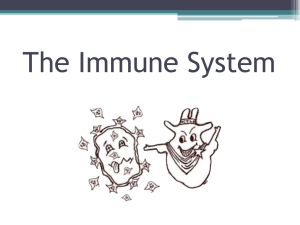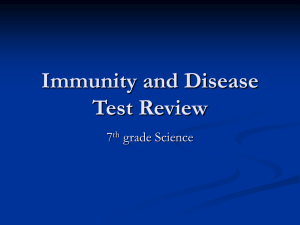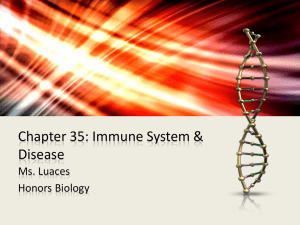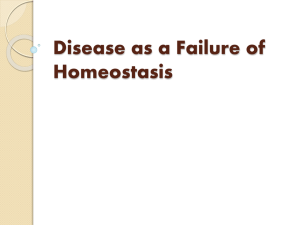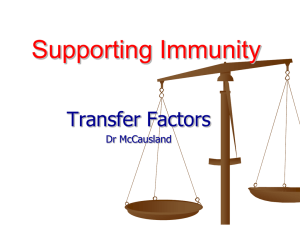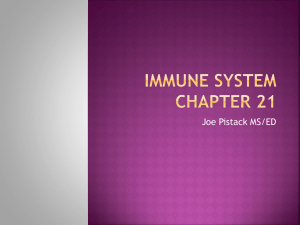BioCH35 - Miami Killian Senior High School
advertisement
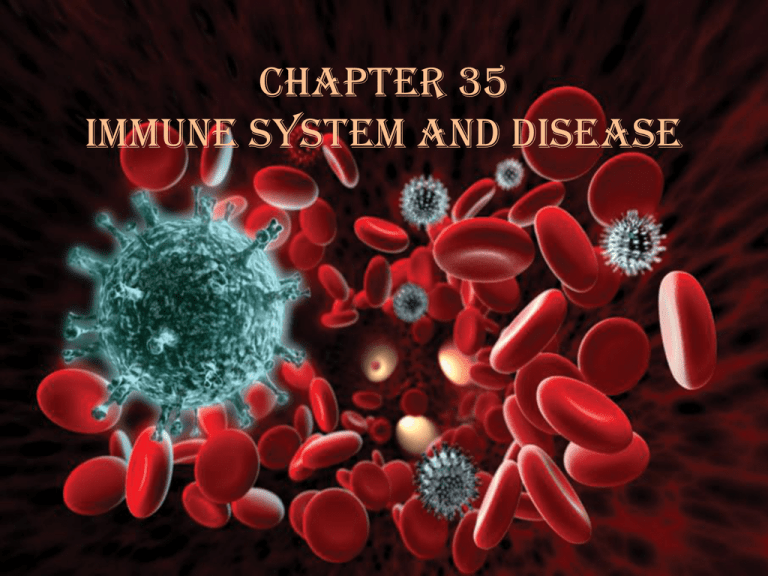
Chapter 35 Immune System and Disease 35.1 35.1 Infectious Disease SC.912.N.1.1,SC.912.N.2.1,SC.912.L.14.52, HE.912.C.1.8,LA.910.2.2.3 Causes Of Infectious Disease What causes infectious diseases? • • • • o o o o o Louis Pasteur, a French Chemist, and Robert Koch, a bacteriologist, established a scientific explanation for infectious disease. Their observations and experiments led to conclude that infectious diseases occur when microorganisms cause physiological changes that disrupt normal body function. Microorganisms were commonly called “germs,” so this conclusion was called the germ theory of disease. Caused by: Viruses Bacteria Fungi Single-celled eukaryotes parasites Agents of disease • Most disease causing microorganisms are called pathogens, except for parasites • Viruses causes a common cold, influenza , chickenpox, warts. • Bacteria causes streptococcus infections, diphtheria, botulism, anthrax. And Fungi causes ringworms and thrush • Protests' causes malaria, African sleeping sickness, and intestinal diseases , while parasitic worms cause trichinosis, schistosomiasis, hookworm, and elephantiasis. Koch’s Postulates • The pathogen must always be found in the body of a sick organism and should not be found in a healthy one. • The pathogen must be isolated and grown in the laboratory in pure culture • When the cultured pathogens are introduced into a healthy host, they should cause the same disease that infected the original host. • The injected pathogen must be isolated from the second host. It should be identical to the original pathogen. Symbionts vs. Pathogens • Most microorganisms that take advantage of our hospitality are symbionts that are either harmless or actually beneficial. • Bacteria grow in the mouth and throat without causing trouble. • Bacteria in the large intestine help with digestion and produce vitamins. • The difference between harmless microorganisms and pathogens is that pathogens obtain nutrients, grow, and reproduce without disturbing normal body functions. How Diseases Spread • Infectious diseases can be spread in a number of ways. Some diseases are spread through coughing, sneezing, physical contact, or exchange of body fluids, and some diseases are spread through contaminated water or food. • Other diseases are spread to humans from infected animals. • Pathogens are often spread by symptoms of disease, such as sneezing, coughing, or diarrhea. • If a virus infects only one host, that virus will die when the host’s immune system kills it or when the host dies. Coughing, sneezing, and physical contact • Many bacteria and viruses that infect the nose, throat, or respiratory tract are spread by indirect contact. • Coughing and sneezing releases thousands of tiny droplets that can be inhaled by other people. • Pathogens such as drug-resistant staphylococci that cause skin cancer infections, can be transferred by almost any kind of body-to-body contact . • The most important means of infection control is through and frequent hand washing. Exchange of body fluids • Some pathogens require specific kinds of direct contact to be transferred from host to host. • A wide range of diseases are transmitted by sexually activity, such as herpes and gonorrhea. • HIV can be transmitted through blood or sexual contact. • Sexually transmitted diseases can only be completely prevented by avoiding sexual activity. Contaminated water or food • Many pathogens that infect the digestive tract are spread trough water contaminated with feces from infected people or other animals. • Diarrhea is a symptom of these diseases. • Contaminated water may carry pathogens onto fruits or vegetables. • Bacteria of several kinds are commonly present in seafood and uncooked meat, especially ground meat. Zoonoses: The Animal Connection • Many diseases that have made it in headlines in recent years thrive in both human bodies and other animal hosts. • A zoonosis is any disease that can be transmitted from animals to humans. • Sometimes an animal carries, or transfers, zoonotic diseases from an animal host to a human host. • Infections may occur when a person is bitten by an infected animal, consumes the meat of an infected animal, or comes in close contact with an infected animal’s wastes or secretions. 35.2 Defenses Against Infection SC.912.N.1.1,SC.912.N.1.6,SC.912.L.14.2,SC.912.L.14.6,HE.912.C.1.8,MA.912.S.3.2 Nonspecific Defenses -What are the body’s nonspecific defenses against pathogens? • The body’s first defense against pathogens is a combination of physical and chemical barriers. • The barriers are called nonspecific defenses because they act against a wide range of pathogens. • Nonspecific defenses include the skin, tears and other secretions, the inflammatory response, interferon's, and fever. First line of defense • The skin is the most widespread nonspecific defense. • Very few pathogens can penetrate the layers of dead cells that form the skin’s surface. • Pathogens could easily enter your body through your mout, nose, and eyes. • Saliva, mucus, and tears contain lysozyme, an enzyme that breaks down bacterial walls. Second line of defense • If pathogens make it into the body for example, through a cut in the skin, the body’s second line of defense swings into action. • The inflammatory response gets its name because it causes infected areas to become red and painful, or inflamed • When viruses infect body cells, certain host cells produce interferon's that inhabit synthesis or viral proteins. • The immune system also releases chemicals that increase body temperature, producing a fever. Specific Defenses: The Immune System -What is the function of the immune system's specific defenses? • The main function of the immune system's specific defenses is easy to describe but complex to explain. • The immune systems specific defenses distinguish between “self” and “other,” and they inactivate or kill any foreign substance or cell that enters the body. • Nonspecific defenses respond to the general threat of infection. • Specific defenses respond to a particular pathogen. Recognizing “Self” • A healthy immune system recognizes all cells and proteins that belong in the body, and treat cells and proteins as “self” • It recognizes chemical markers that act like a secret password that says “ “ I belong here. Don’t attack me!” • The immune system controls powerful cellular and chemical weapons that could cause problems if turned against the body’s own cells. • The ability to recognize “self” is essential. . Recognizing “ Nonself” • The immune system recognizes foreign organisms and molecules as “other” or “nonself” • After encountering a specific invader, the immune system remembers it. • The immune memory enables a more rapid and effective response if that same pathogen attacks again. • The immune response is the response and memory. Antigens • Specific immune defenses are triggered by molecules called antigens. • They are located on the outer surfaces of bacteria, viruses, or parasites. • The immune system responds to antigens by increasing the number of cells that either attack the invaders directly or that produce proteins called antibodies. • Antibodies main role is to tag antigens for destruction by immune cells. Lymphocytes • The main working cells of the immune response are B lymphocytes and T lymphocytes. • B cells are produced and mature in red bone marrow • T cells are produced in the bone marrow but mature in the thymus, an endocrine gland. • A persons genes determine the particular B and T cells that are produced. The Immune System in Action - What are the body’s specific defenses against pathogens? • The specific immune response has two main styles of action, which are humeral immunity and cell-mediated immunity. • B and T cells continually search the body for antigens or signs of antigens. Humeral Immunity • Humeral immunity depends on the action of antibodies that circulate in the blood and lymph. • Plasma cells produce and release antibodies that are carried through the bloodstream. • Plasma cells die after an infection is gone, but some B cells that recognize a particular antigen remain alive, and these cells are called memory B cells. • The memory B cells react quickly if the same pathogen enters the body again. Cell-Mediated Immunity • Cell-mediated immunity depends on the action of macrophages and several types of T cells • When a cell is infected by a pathogen or when a macrophage consumes a pathogen, the cell displays a portion of the antigen on the outer surface of its membrane. • Cytotoxic T cells hunt down body cells infected with a particular antigen and kill the cells. • Suppressor T cells helps to keep the immune system in check. 35.3 Fighting Infectious Disease sc.912.n.1.1,sc.912.l.14.6,sc.912.l.14.52,he.912.c.1.3,he.912.c.1.8 Acquired Immunity - How do vaccines and externally produced antibodies fight disease? • The adaptive immune system, also known as the acquired immune system or, is composed of highly specialized, systemic cells and processes that eliminate or prevent pathogen growth. • Vaccinations protect you from specific diseases that can make you very sick, disable or even kill you. • They boost your body's own defense system, which is also called the immune system. • Vaccines create immunity that protects you from an infection without causing the suffering of the disease itself. Active Immunity • Vaccination stimulates the immune system with an antigen • The immune system produces memory B cells and memory T cells that quicken and strengthen the body’s response to repeated infection. • Active immunity may develop as a result of natural exposure to an antigen or from deliberate exposure to the antigen. Passive Immunity • Antibodies produced against a pathogen by other individuals or animals can be used to produce temporary immunity. • Passive immunity is the result if externally produced antibodies are introduced into a persons blood • Passive immunity can also occur naturally or by deliberate exposure • Natural passive immunity also occurs when antibodies are passed from a prenant women to the fetus, or to an infant through breast milk. Public Health and Medications -How do public health measures and medication fight disease? • In 1900, more than 30% of deaths in the United States were caused by infectious disease. • In 2005, less than 5% of deaths were caused by infectious disease. • Two factors that contributed to this change are public health measures and the development of medications. Public Health Measures • When humans live in large groups, behavior, cleanliness of food and water supplies, and sanitation all influence the spread of disease. • The field of public health offers services and advice that help provide healthy conditions. • Public health measures help prevent disease by monitoring and regulating food and water supplies, promoting vaccination, and promoting behaviors that avoid infection. • Promoting childhood vaccination and providing clean drinking water could reduce the spread of many diseases that once killed many people. Medication • Antibiotics can kill bacteria , and some antiviral medications can slow down viral activity • Antibiotic refers to a compound that kills bacteria without harming its host. • In 1928, Alexander Fleming was the first scientist to discover an antibiotic. • Antibiotics have no effect on viruses; however, antiviral drugs have been developed to fight certain viral infections. New and Re-Emerging Diseases -Why have patterns of infectious diseases changed? • By 1980, many people thought that medicine had conquered infectious diseases. • Vaccination and other public health measures had wiped out polio in the United States and had eliminated smallpox globally. • In recent decades, a host of new diseases have appeared, including AIDS, SARS, hantavirus, monkeypox, West Nile Virus, Ebola, and avian influenza • Other diseases that people thought were under control are re-emerging as a threat and spreading to new areas Changing Interactions With Animals • Two major reasons for the emergence of new diseases are the ongoing merging of human and animal habitats and the increase in the exotic animal trade. • As people clear new areas of land and as environments change, people come in contact with different animals and different pathogens. • Both monkey pox and SARS are thought to have started that way. • Pathogens are also evolving in ways that enable them to infect different hosts. Misuse of Medication • It has led to the re-emergence of diseases that many people thought were under control. • Many trains of the pathogens that cause tuberculosis and malaria are evolving resistance to a wide variety of antibiotics and other medications. • Diseases such as measles are making a comeback because some people fail to follow vaccination recommendations. 35.4 IMMUNE SYSTEM DISORDERS SC.912.N.1.1,SC.912.N.1.6,SC.912.L.14.6,HE.912.C.1.8,MA.912.S.3.2 When the Immune System Overreacts -How can misguided immune responses cause problems? • The immune systems of some people overreact to harmless antigens, such as pollen, dust mites, mold, pet dander, and possibly their own cells. • A strong immune response to harmless antigens can produce allergies, asthma, and autoimmune disease. Allergies • Antigens that cause allergic reactions are called allergens • When allergens enter the body of people affected by allergies, they trigger inflammatory response by causing mast cells to release histamines. • If this response occurs in the respiratory system, it increases mucus production and causes sneezing, watery eyes, a runny nose, and other irritations. • Drugs called antihistamines help relieve allergy symptoms by counteracting the effects of histamines. Asthma • Allergic reactions in the respiratory system can create a dangerous condition called asthma. • Asthma is a chronic disease in which air passages narrow, causing wheezing, coughing, and difficulty breathing. • Asthma is serious and can be life-threatening, and it can lead to permanent damage or destruction of lung tissue. • There is no cure, but people with it can sometimes control the condition. Autoimmune Diseases • Sometimes a disease occurs in which the immune system fails to properly recognize “self” and attacks cells or compounds in the body as though they were pathogens. • When the immune system attacks the body’s own cells, it produces an autoimmune disease. • In type 1 diabetes, antibodies attack insulin- producing cells in the pancreas • Some autoimmune diseases can be treated with medications that aleviate specific symptoms. • HIV and AIDS -What causes AIDS and how is it spread? • During the late 1970s, physicians began reporting serious infections produced by microorganisms that didn’t normally cause disease. • Diseases that attack a person with a weakened immune system are called opportunistic diseases. • Research eventually revealed that this “syndrome” was an infectious disease caused by a pathogen new to science. HIV • In 1983, researchers identified the causes of AIDS, a virus they called human immunodefiancy virus • HIV is deadly for two reasons, it can hide from the defenses of the immune system and it attacks key cells within the immune system, leaving the body with inadequate protection against other pathogens. • HIV is a retrovirus that carries its genetic information in RNA, rather than DNA • When HIV attacks a cell, it binds to receptor molecules on the cell membrane and inserts its contents into the cell. Target: T Cells • Among HIV’s main targets are helper T cells, the command centers of the specific immune response. • Over time, HIV destroys more and more T cells, crippling the ability of the immune system to fight HIV and other pathogens. • The fewer helper T cells, the more advanced the disease, and the mpre susceptible the body becomes to other diseases. • When an HIV- infected person’s T cell count reaches about one sixth the normal level, he or she is diagnosed with AIDS. HIV Transmission • HIV is not easily transmitted • HIV can only be transmitted through contact with infected blood, semen, vaginal secretions, or breast milk. • The four main ways that HIV is transmitted are sexual intercourse with an infected person, sharing a needle, contact with infected blood, or from an infected mother to her child during pregnancy, birth, or breast-feeding. Preventing HIV Infection • The only no-risk behavior with respect to HIV transmission is abstinence from sexual activity and intravenous drug use • Within a committed relationship , such as marriage , sexual fidelity between two uninfected partners presents the least risk of becoming infected with HIV. • People who share needles to inject themselves with drugs are at high risk for contracting HIV. • Before 1985, HIV was transmitted to some patient through transfusions of infected blood or blood products. Can AIDS Be CURED? • At present, there is no cure for AIDS. • A steady steam of new drugs makes it possible to survive HIV infection for years, unfortunately, HIV mutates and evolves rapidly. • The only way to control the virus is to use a combination of expensive drugs that fight the virus in several ways. • The knowledge that HIV can be treated has given some people the misconception that HIV infection is not serious.


